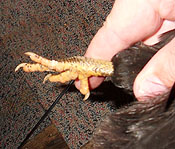

It is well known that Japanese bantams carry a lethal gene related to leg length. This article explains the genetics of this condition.
There are a number of lethal genes in poultry, however in Japanese bantams, the Creeper (Cp) gene is the offender. This is a skeletal shortening mutation which is also found in other short-legged breeds such as Scots Dumpies.
There are two main types of genetic traits, these being heterozygous and homozygous. I will quote the experts in describing the technical stuff.
A diploid organism is heterozygous at a gene locus when its cells contain two different alleles of a gene. Heterozygous genotypes are represented by a capital letter (representing the dominant allele) and a lowercase letter (representing the recessive allele), such as "Rr" or "Ss". The capital letter is usually written first. (Lodish, et al: Molecular Cell Biology, 4th edition, 2000)
A cell is said to be homozygous for a particular gene when identical alleles of the gene are present on both homologous chromosomes. The cell or organism in question is called a homozygote. True breeding organisms are always homozygous for the traits that are to be held constant. (Lawrence, Eleanor: Henderson's Dictionary of Biology, 2008)

All Japanese bantams with proper leg length are heterozygous, however the embryos can have one of three possible genetic combinations for leg length; two being homozygous and one heterozygous. Of these three possibilities, only two can survive to hatching. To illustrate the combinations, I shall (unscientifically) label the two alleles as thus: long leg length (L or l) and the short leg length (S). So the possible combinations can be shown as follows:
(Ll)= These do not have the creeper gene. They will all have long legs and when mated together cannot breed short legged chicks.
(Sl)= Proper Japanese bantams. Chicks with this combination will have short legs as demanded by the standard. When mated together, they will (theoretically) give 50 per cent short-legged chicks (Sl), 25 per cent long-legged chicks (Ll) and 25 per cent lethal (Ss).
(Ss)= The lethal combination. Embryos with this combination are homozygous and will always die before they can hatch.
Breeders of Japanese bantams all strive to breed birds with the short legs required, however they may use different strategies to get them. Some will mate short-legged birds with long-legged birds which removes the chance of any embryos having the lethal (Ss) combination and all fertile eggs will hatch. The main drawback of this strategy is that it increases the number of long-legged chicks to 50 per cent. Therefore, the incidence of "wasters" is greatly increased. Most serious breeders however, will mate two short-legged birds together. The advantages of this strategy are: the number of correct short-legged birds is maintained at 50 per cent, and the eggs containing chicks with the lethal (Ss) genes do not hatch anyway. The percentage of "wasters" is therefore reduced naturally.
Notwithstanding the genetics (which always work perfectly in the text books, but never so well in practice) there seems to be an increase in Japanese bantams with, what I would term, intermediate length legs. Having looked at many pictures and live examples of the breed, I surmise that some strains have, in the past, been crossed with Indian Game bantams, probably to improve the stoutness of bone.
Now, Indian Games also have a short leg gene, however it is not completely lethal. Frederick Hutt, in his excellent book Genetics of the Fowl (1949) called this gene Cl. It is quite likely that Japanese bantams that have this gene, in addition to the Cp gene would be predisposed to having longer legs than desirable, without them being fully long-legged. Because the difference between CP and Cl-based strains would be almost impossible to tell apart, it is also likely that birds with the Cl gene in their makeup would tend towards this intermediate leg length, without the lethal factor.

